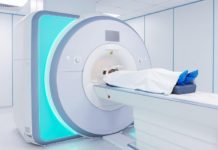A specially designed computer program can help diagnose post-traumatic stress disorder (PTSD) in veterans by analyzing their voices, a new study finds.
Published online April 22 in the journal Depression and Anxiety, the study found that an artificial intelligence (AI) tool can distinguish—with 89 percent accuracy—between the voices of those with and without PTSD.
“Our findings suggest that speech-based characteristics can be used to diagnose this disease, and with further refinement and validation, may be employed in the clinic in the near future,” says senior study author Charles R. Marmar, MD, the Lucius N. Littauer Professor and chair of the Department of Psychiatry at NYU School of Medicine.
More than 70 percent of adults worldwide experience a traumatic event at some point in their lives, with up to 12 percent of people in some struggling countries suffering from PTSD. Those who have the condition experience strong, persistent distress when reminded of a triggering event.
The study authors say that a PTSD diagnosis is most often determined by clinical interview or a self-report assessment, both inherently prone to biases. This has led to efforts to develop objective, measurable, physical markers of PTSD progression, much like laboratory values for medical conditions, but progress has been slow.
In the current study, the research team used a statistical machine learning technique, called random forests, that can “learn” how to classify individuals based on examples. Such AI programs build “decision” rules and mathematical models that improve decision-making accuracy as the amount of training data increases.
The researchers first recorded standard, hours-long diagnostic interviews, called Clinician-Administered PTSD Scale, or CAPS, of 53 Iraq and Afghanistan veterans with military service–related PTSD, as well as those of 78 veterans without the disease. The recordings were then fed into voice software from SRI International—the institute that also invented Apple’s Siri—to yield a total of 40,526 speech-based features captured in short spurts of talk, which the team’s AI program sifted through for patterns.
The random forest program linked patterns of specific voice features with PTSD, including less clear speech and a lifeless, metallic tone, both of which had long been reported anecdotally as helpful in diagnosis. While the current study did not explore the disease mechanisms behind PTSD, the theory is that traumatic events change brain circuits that process emotion and muscle tone, which affects a person’s voice.
Moving forward, the research team plans to train the AI voice tool with more data, further validate it on an independent sample, and apply for government approval to use the tool clinically.
“Speech is an attractive candidate for use in an automated diagnostic system, perhaps as part of a future PTSD smartphone app, because it can be measured cheaply, remotely, and nonintrusively,” says lead author Adam D. Brown, PsyD, adjunct assistant professor in the Department of Psychiatry at NYU School of Medicine.
“The speech analysis technology used in the current study on PTSD detection falls into the range of capabilities included in our speech analytics platform called SenSay Analytics™,” says Dimitra Vergyri, director of SRI International’s Speech Technology and Research Laboratory. “The software analyzes words—in combination with frequency, rhythm, tone, and articulatory characteristics of speech—to infer the state of the speaker, including emotion, sentiment, cognition, health, mental health, and communication quality. The technology has been involved in a series of industry applications visible in startups like Oto, Ambit, and Decoded Health.”
Along with Dr. Marmar and Dr. Brown, who is also an associate professor of psychology at the New School for Social Research, authors of the study from the Department of Psychiatry were Meng Qian; Eugene M. Laska, PhD; Carole Siegel, Meng Li; and Duna Abu-Amara. Study authors from SRI International were Andreas Tsiartas, Dimitra Vergyri, Colleen Richey, Jennifer Smith, and Bruce Knoth.
The study was supported by the U.S. Army Medical Research Acquisition Activity (USAMRAA) and Telemedicine and Advanced Technology Research Center (TATRC) grant W81XWH-ll-C-0004, as well as by the Steven and Alexandra Cohen Foundation.
























